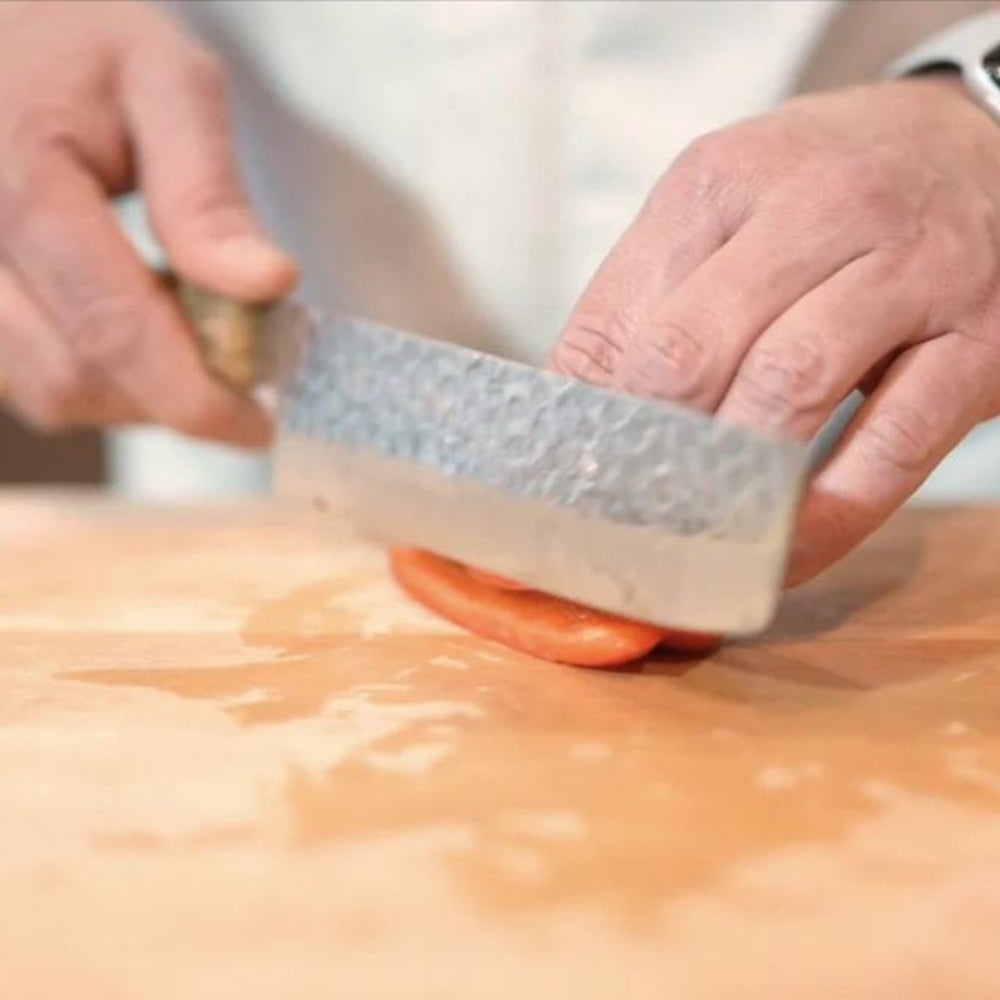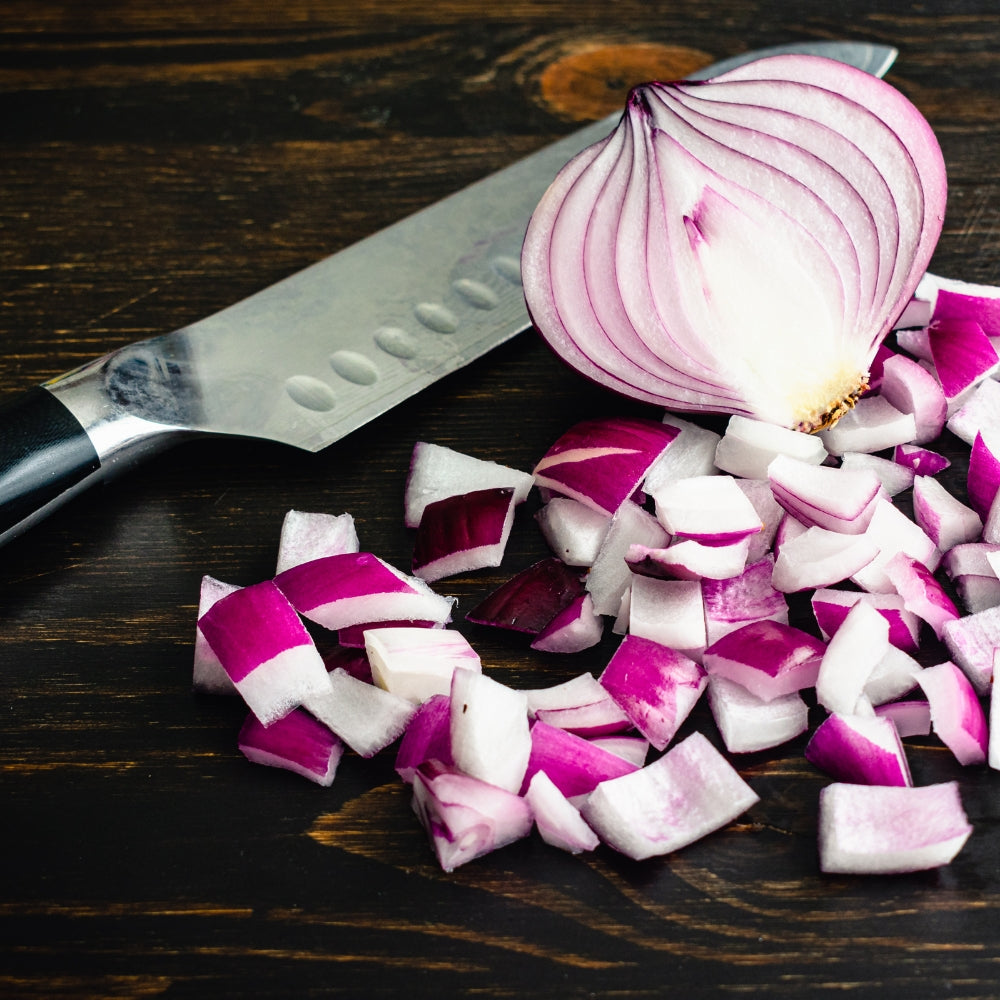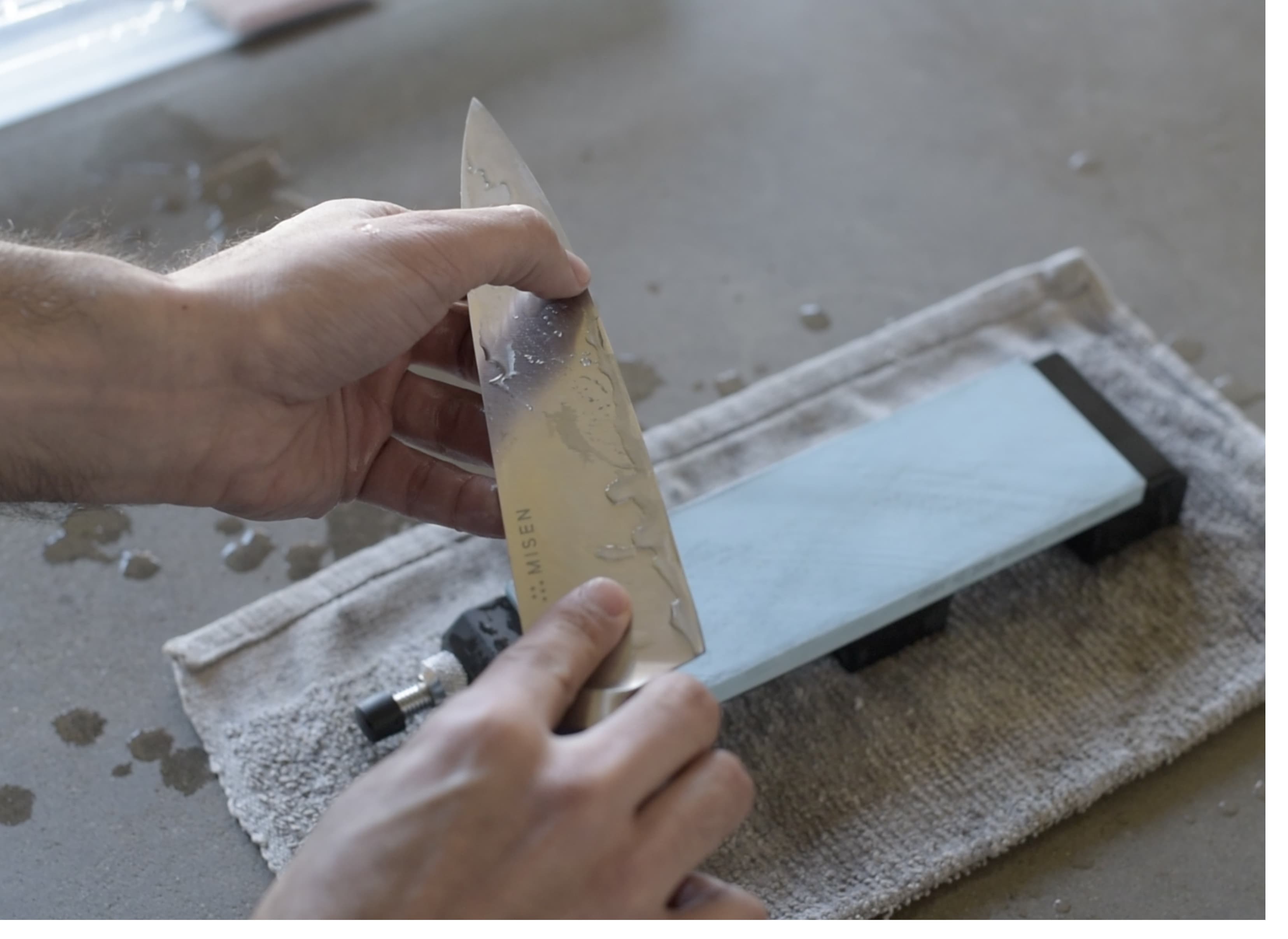
Perfecting Veggie Prep: How to Use a Nakiri Knife
By Andrew Sahatjian
Senior Food Writer at Pro Home Cooks
When it comes to prepping vegetables, knowing how to use a nakiri knife can be a game-changer. This traditional Japanese blade is designed for precision cutting, making it an essential tool in any kitchen.
The Nakiri knife's unique design and sharp edge make slicing through veggies as easy as pie. It offers superior control and balance that ensures your safety while handling the knife.
A good grip on your Nakiri will ensure you get those perfect slices every time. But using this type of knife isn't just about holding it right; there are specific cutting techniques to master too.
In our comprehensive guide, we'll dive into everything from the correct way of gripping your Nakiri to achieving professional presentation cuts with ease. Stay tuned if you're looking to take your vegetable prep skills up a notch with expert tips on how to use a nakiri.
Ready to elevate your culinary game? Dive deeper into our top picks and discover the best in cookware. Explore now!
- Understanding the Nakiri Knife
- Perfecting Veggie Prep: How to Use a Nakiri Knife
- Proper Grip and Knife Handling
- Up Next: Essential Cutting Techniques With A Nakiri Knife
- Mastering Veggie Prep: How to Use a Nakiri Knife
- Perfecting Veggie Prep: How to Use a Nakiri Knife
- Perfecting Veggie Prep: How to Use a Nakiri Knife
- Knife Care and Maintenance
- Knife Care and Maintenance
- Additional Tips And Considerations
- Recommended Nakiri Knives
- Recommended Nakiri Knives
- FAQs in Relation to How to Use Nakiri Knife
- Conclusion
Understanding the Nakiri Knife
The Nakiri knife, with its distinctive rectangular blade and flat edge, is a chef's dream for effortlessly slicing through vegetables. The unique design of this culinary tool ensures clean cuts without crushing or bruising your ingredients.
Types of Nakiri Knives
In the world of cutlery, you'll find various types of Nakiri knives, each designed to cater to specific kitchen needs. From standard versions ideal for routine tasks to extra-large ones perfect for more demanding chopping jobs, there's a Nakiri knife suited just right for every home cook.
Distinguishing between different kitchen knives can seem like an uphill task if you're new to the cooking arena. However, once familiarized with the features and design of a Nakiri knife, spotting it amidst other options such as paring or chef’s knives becomes second nature.
The absence of a tip on these tools not only sets them apart visually but also aids in making precise cuts on delicate veggies without any damage. This characteristic feature ties back to their Japanese origin, where they were crafted as essential implements both by professional chefs and household cooks alike.
Grip Importance With a Nakiri Knife
A firm grip while handling sharp tools like nakiris goes beyond ensuring safety; it’s about achieving control and balance during cutting operations too. Experts vouch for the pinch grip technique, wherein the thumb and index finger are positioned on the blade rather than the handle, enhancing user command over the cutting process.
This might feel unfamiliar initially but eventually turns into a habit, making your time in the kitchen much safer and enjoyable. So next time when prepping meals, remember to pick up that trusty nakiri knife and practice your newly acquired skills. Stick around as we go deeper into proper handling techniques, maximizing the use of this popular Japanese kitchen implement in our upcoming section on 'Proper Grip and Handling'.
Don't underestimate the power of a Nakiri knife. Its distinctive rectangular blade and flat edge are perfect for slicing veggies without crushing them. Various types cater to different kitchen needs, but what sets it apart is its lack of tip - great for precise cuts on delicate produce. The secret? A firm pinch grip on the blade that ensures control and balance during cutting operations.
Perfecting Veggie Prep: How to Use a Nakiri Knife
From perfect grip techniques to precision cuts, we've got you covered.
Proper Grip and Knife Handling
A Nakiri knife, just like a beloved carbon steel pan, can become an extension of your hand in the kitchen. It's all about understanding the importance of a proper grip for control, balance, and safety during food preparation.
Take note: it isn't some innovative technology that has recently hit our kitchens; instead, it is rooted in traditional culinary practices. A pinch grip technique for Nakiri knife use brings together age-old wisdom with modern-day cooking needs - thumb and index finger on opposite sides of the blade base while three fingers give handle support.
The challenge with using this particular type of Japanese vegetable cutter is similar to maintaining non-stick pans – they both require specific handling techniques. Holding the knife handle correctly may seem as finicky as preserving your non-stick pan’s coating but trust us when we say mastering this will change your game.
Nakiri Knife: An Extension Of Your Hand
You don’t need to be overly cautious or walk on eggshells around them - embrace their function. Proper hand placement is crucial to efficient vertical chopping with a nakiri knife much like how high-heat cooking enhances carbon steel pans' performance without damaging them.
So go ahead. Use these tools until you feel comfortable enough that they practically become extensions of yourself. Once you’ve gotten used to wielding them properly (like developing patina naturally through regular usage), every cut will come out perfect.
Maintaining Balance And Control
In contrast to other cutting tools where precision might get compromised over time due to wear and tear or incorrect storage methods – correct handling ensures longevity here. The right hold not only guarantees efficiency but also keeps fatigue at bay allowing longer periods of productivity.
Up Next: Essential Cutting Techniques With A Nakiri Knife
So, we've nailed down just how crucial it is to hold a nakari knife the right way.
When it comes to mastering veggie prep, a Nakiri knife can be your best ally. It's not just about wielding the blade; it's about grasping age-old wisdom and adapting it to modern needs. Much like caring for non-stick pans or carbon steel pans, proper grip and handling techniques are key. So roll up your sleeves and get comfortable with
Mastering Veggie Prep: How to Use a Nakiri Knife
The nakiri knife, also known as the 'leaf' or 'vegetable cutter' in Japanese, is the ultimate tool for precise vegetable cuts. Its straight square blade provides unmatched accuracy and control when slicing through your favorite veggies.
Precision Cuts for Professional Presentation
With a nakiri knife in hand, you can effortlessly create stunning julienne and matchstick cuts. These uniform slices not only look impressive but also cook evenly, enhancing the overall taste of your dish.
To achieve a professional presentation at home, start by slicing the vegetable lengthwise into thin strips. Then, neatly stack these slices before cutting them again to form slender matchsticks - perfect for adding an elegant touch to salads or stir-fries.
Techniques for Cutting Leafy Greens
Cutting leafy greens like lettuce or cabbage can be challenging due to their delicate structure. However, the flat edge and sharp blade of a nakiri knife make it a breeze to tackle these tasks without bruising or tearing the leaves.
Lay out each leaf on top of another, then tightly roll them up before making horizontal cuts across the roll. This technique results in beautiful chiffonade ribbons that add texture and visual appeal to any salad bowl.
Perfecting Veggie Prep: How to Use a Nakiri Knife
Going beyond essential cutting techniques with a nakiri knife, let's explore the best ways to prepare different types of vegetables. From peeling and trimming hard vegetables like squash to efficiently handling large quantities, our upcoming sections will provide valuable insights. Stay tuned.
Efficiently Cutting Large Quantities of Vegetables
The straight square blade design of a nakiri knife allows you to handle large volumes with ease while minimizing wastage during peeling and trimming processes. The following sections will go deeper into preparation tips that make cooking less daunting, all while significantly improving your culinary skills. Let's keep going.
Embrace the nakiri knife, your new best friend in the kitchen. With its straight square blade, it's a pro at precise cuts for professional presentation. Whether you're julienning veggies or cutting leafy greens into beautiful chiffonade ribbons, this Japanese 'vegetable cutter' has got your back. And guess what? It even makes handling large
Perfecting Veggie Prep: How to Use a Nakiri Knife
From perfect grip techniques to precision cuts, we've got you covered.
Efficiently Cutting Large Quantities of Vegetables
The true art in efficiently cutting large quantities of vegetables is mastering your nakiri knife. It’s designed specifically to make quick work of veggies, whether it's delicate ones or hard squash and pumpkin. This Japanese kitchen essential brings speed and accuracy without sacrificing safety.
Start by peeling and trimming vegetables before moving on to more complex cuts. Just like finding the joint between two bones that are keeping the chicken together, there is an order when dealing with vegetables too.
Maintaining cleanliness during food preparation is just as crucial as making those perfect slices. Keep separate sections for uncut produce, waste material, and finished product. Not only does this method boost efficiency, but it also ensures your workspace remains clean throughout.
And now we move from discussing tips on vegetable prep using our trusty nakiri knife onto maintaining these tools so they last generations.
Knife Care and Maintenance
Caring for your nakiri isn't unlike tending to a chef's knife—cleaning and drying after each use helps ward off rust; safe storage prevents damage; regular sharpening keeps that blade sharp, ensuring edge retention.
Using Sharpening Stones or Honing Rods
Your nakiri needs love beyond cleaning—it craves sharpening too. Knowing when and how to use sharpening stones or honing rods will prolong both its lifespan and performance level, just like understanding where exactly to slice through can turn anyone into an expert butcher overnight.
Just remember: caring about post-cooking routines matters as much as prepping those flawless veggie slices. Stay tuned next where we dive deeper into efficient maintenance practices.
Embrace the power of a nakiri knife for your veggie prep, and you'll be slicing and dicing like a pro in no time. This Japanese kitchen essential not only ensures speed and accuracy but also guarantees safety. And remember, it's not just about mastering those precision cuts; keeping your workspace clean and maintaining your tools are equally important.
Knife Care and Maintenance
Your Nakiri knife, like a well-loved kitchen partner, deserves care and attention. This includes not just the act of cleaning and drying the Nakiri Knife but also storing it safely to ensure its longevity.
Cleaning Your Nakiri Knife
Consider your nakiri as an extension of your culinary hand - never let it sit dirty for long. A swift clean with warm water and mild soap after use keeps unwanted residues at bay.
The next step is crucial: Drying the Nakiri Knife thoroughly prevents any moisture-related damage such as rusting. Use a soft cloth or towel; slide from spine towards the cutting edge for safety and effectiveness.
Storing The Nakiri Knife Safely
A safe home for your knife ensures both you and your tool are protected. Storing knives loose in drawers isn't ideal – they can get damaged or cause accidents when reaching inside blindly.
Magnetic strips affixed away from high traffic areas or drawer inserts designed specifically for storing knives provide secure homes where blades are shielded while providing easy access whenever needed.
Maintaining Sharpness: Honing vs Sharpening
Nakiris, like other types of knives, require regular maintenance to retain their sharpness over time – an important aspect that contributes significantly to blade longevity and edge retention.
Sharpening stones play an essential role here by removing material off the blade's surface, whereas honing rods realign any microscopic teeth along a blade’s edge that may have bent out of alignment during usage.
Knowing how to use these tools properly helps keep our favorite utensils performing optimally but also extends their useful lifespan considerably by reducing wear and tear caused by improper handling and neglectful treatment.
Now let's explore some additional tips and considerations pertaining to the selection process and other aspects associated with owning such a special piece of culinary equipment.
Just like any valued kitchen ally, your Nakiri knife craves some TLC. Quick cleans post-use with warm water and mild soap, thorough drying to avoid rusting, and secure storage in a dedicated spot are all part of the package. Keep it sharp by knowing when to hone versus sharpen - remember, stones remove material while rods realign bent teeth on the blade
Additional Tips And Considerations
However, it's crucial to recognize how pairing the nakiri with other kitchen tools can maximize its utility.
Exploring Different Steel Types For Nakiri Knives
Different steel types imbue Nakiri knives with unique performance characteristics and durability levels. Some blacksmiths even push boundaries by crafting extra-large versions of the Nakiri for specialized culinary tasks.
Navigating through these different steel types may seem overwhelming at first, but understanding their distinct properties will aid you in selecting a Nakiri that best suits your cooking style.
If expanding your collection is on your mind, take into account factors such as frequency of use or what dishes you usually prepare. This approach will guide you when exploring various steel types for Nakiri knives.
Recommended Nakiri Knives
Finding high-quality options across diverse budgets becomes simpler once we go into top Nakiri brands worthy of consideration.
Reviews And Comparisons Of Popular Nakiri Knives
An effective way to begin this journey involves diving deep into detailed reviews and comparisons between popular Nakiri models before making any purchase decision.
A reliable resource offers an extensive range of Nakiris from multiple blacksmiths and knife lines. You'll discover choices ranging from affordable beginner-friendly variants to premium offerings crafted by esteemed artisans.
In our subsequent section, we're going to further explore specific recommendations based on quality, price point, and user feedback. If finding the perfect Nakiri Knife aligns with your culinary goals, don't miss out.
Recommended Nakiri Knives
Description: Are you in search of the best nakiri knives? There are numerous brands to explore, each offering high-quality options across different budgets. From affordable nakiri knives to those that showcase traditional Japanese blacksmith artistry, there's a perfect choice for every home cook.
Reviews and Comparisons of Popular Nakiri Knives
Description: Before making a purchase decision, it's important to take a closer look. Detailed reviews and comparisons of popular nakiri knife models can provide valuable insights into their unique features and benefits, specifically tailored for various culinary tasks.
Are you curious about where to get a wide array of choices? Well, one option is Knifewear, which offers an extensive range of nakiri knives from diverse blacksmiths and knifelines (although we are not promoting them here). They combine traditional Japanese craftsmanship with modern design aesthetics in their selection.
To give you a sneak peek into the current market offerings:
Kanetsune Nakiri Knife
Let me introduce you to a model that stands out in terms of quality - The Kanetsune Nakiri Knife. It is renowned for its exceptional sharpness and edge retention, thanks to its VG-10 stainless steel core wrapped with Damascus Steel layers – truly a marvel.
Takamura HSPS Pro Nakiri Knife
If you appreciate luxury, then the Takamura HSPS Pro Nakiri knife should catch your eye. This knife is adored by professional chefs worldwide for its unparalleled sharpness achieved through High-Speed Powdered Steel (HSPS), making it a shining star in any kitchen.
Different Budget Options for Quality Nakiri Knives
If budget constraints are holding you back, don't worry. There are numerous reputable brands that offer exceptional value-for-money nakiri knives without compromising on performance or durability.
Tojiro DP Series
An excellent example is the Tojiro DP series; it combines affordability with reliable functionality. This series is ideal for those who are new to cooking or need an everyday tool in their kitchen arsenal.
Scouring for the perfect nakiri knife? Choices abound, from budget-friendly options to traditional Japanese masterpieces. Consider detailed reviews and comparisons before purchasing. Brands like Kanetsune and Takamura offer top-notch quality while Tojiro DP series delivers bang for your buck. So, whether you're a culinary novice or seasoned chef, there's a nakiri knife
FAQs in Relation to How to Use Nakiri Knife
What is a Nakiri knife good for?
A Nakiri knife is perfect for chopping, slicing, and dicing vegetables. Its flat edge and thin blade allow for precise cuts without crushing the produce.
Can I use a Nakiri knife for meat?
While you can technically use a Nakiri knife for meat, it's not ideal. The lack of a pointed tip makes it less suitable for deboning or piercing tasks. Its true strength lies in its ability to handle vegetables.
How do you handle a Nakiri knife?
To properly handle a Nakiri knife, use the pinch grip technique. Hold the top of the blade between your thumb and index finger while wrapping your other fingers around the handle.
Is a Santoku better than a Nakiri?
Choosing between a Santoku and a Nakiri depends on your preferences. Both knives are versatile, but Santokus are more multipurpose while Nakiris excel in vegetable preparation.
Conclusion
Mastering the Nakiri knife is a game-changer for any home cook. The unique design and precision it offers make vegetable prep an absolute breeze. Whether you're a seasoned chef or a beginner in the kitchen, learning how to use a Nakiri knife will take your culinary skills to the next level.
One of the first things you need to know about the Nakiri knife is its distinct features. From its flat blade to its squared-off tip, this Japanese knife is specifically designed for slicing and dicing vegetables with ease. With its razor-sharp edge, you can achieve precise cuts and create beautifully presented dishes.
When it comes to choosing a Nakiri knife, there are different types available in the market. From traditional carbon steel blades to modern stainless steel options, you can find the one that suits your preferences and needs. Consider factors like durability, maintenance, and sharpness when selecting the right Nakiri knife for your kitchen.
Once you have your Nakiri knife, it's important to handle it with care for safety and balance. Hold the knife with a firm grip, ensuring your fingers are curled under and your thumb rests on the blade's spine. This grip provides stability and control while cutting, reducing the risk of accidents.
Now that you have the basics
Transform your kitchen experience with the best tools handpicked by Mike. Don't miss out on these essentials. Check out our top Japanese knives now!
TOP ARTICLES

Sourdough Baking School
Master the art of sourdough bread baking in the most comprehensive baking class on the internet. This class features over three hours of baking content to help you start your sourdough journey.
See More




